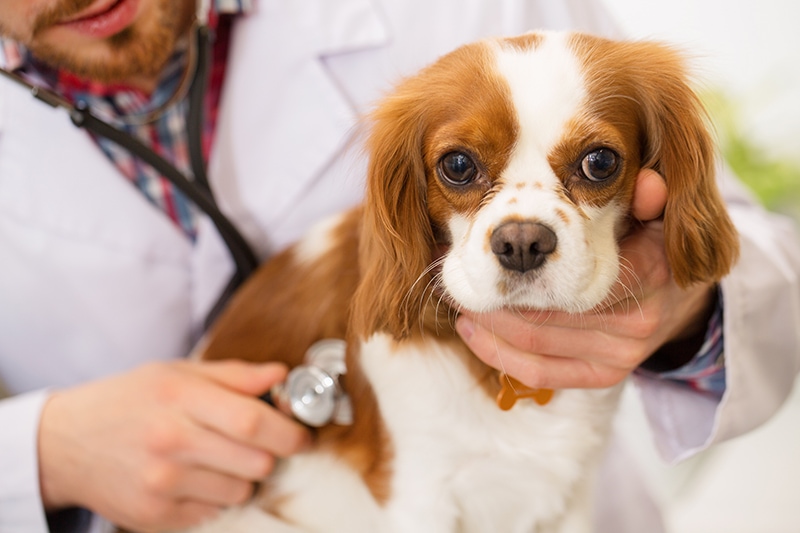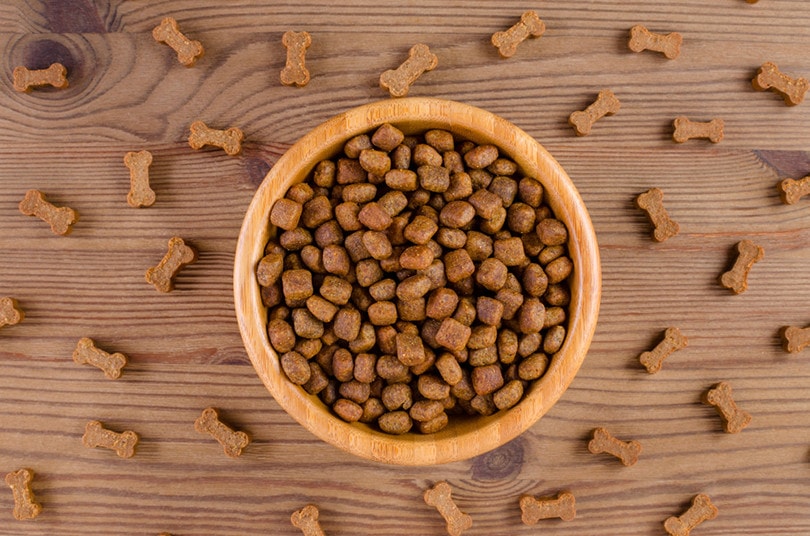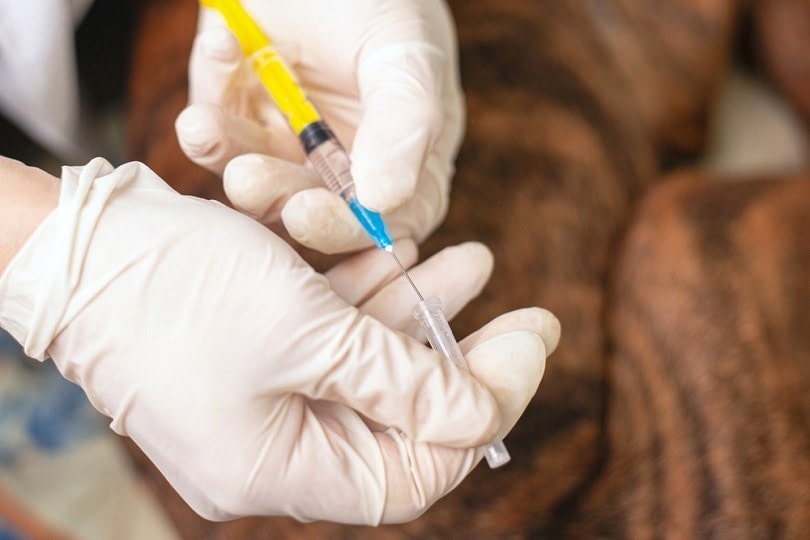Burned Dog Paws: Signs, Prevention & Treatment (Vet Answer)

Updated on
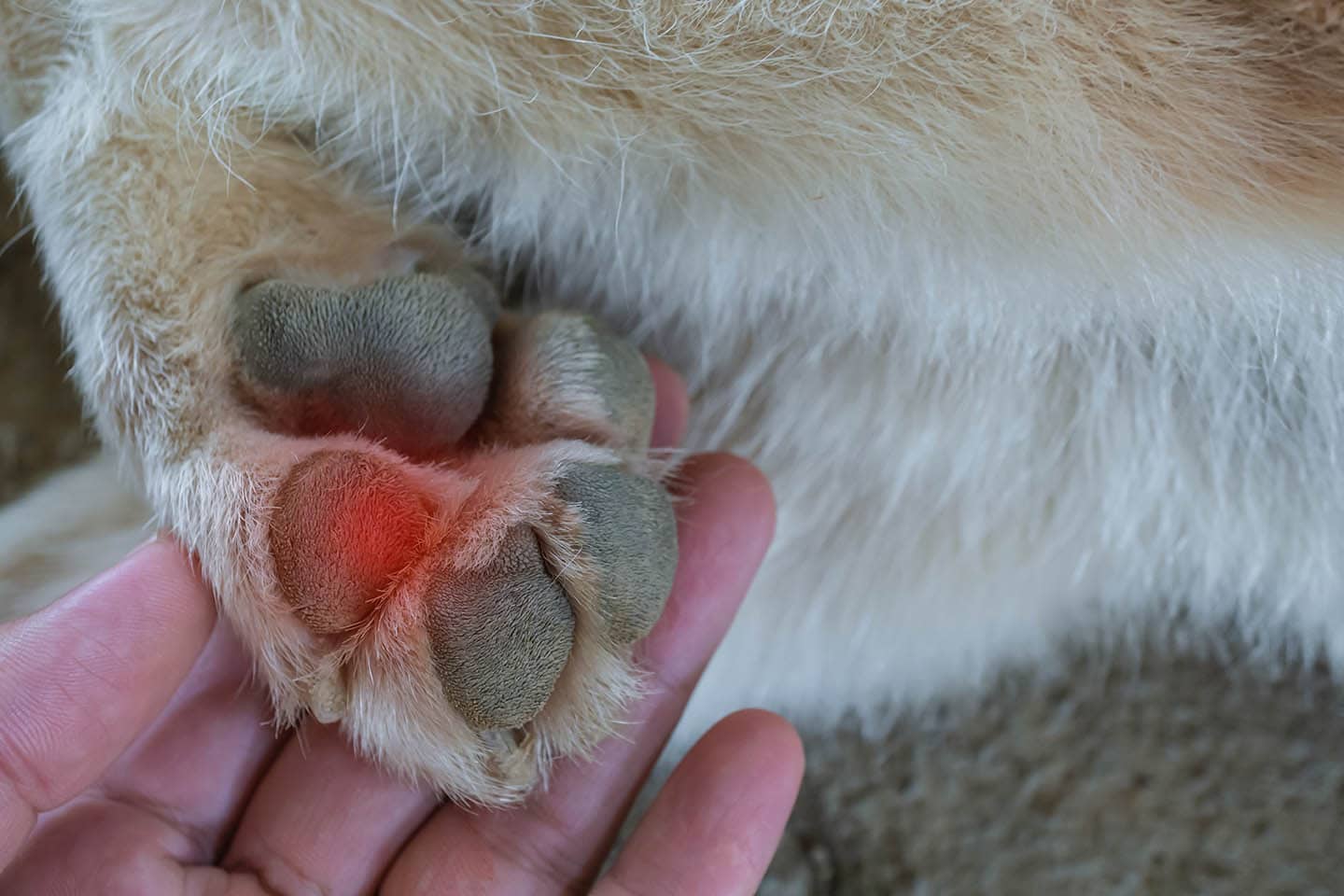
Click to Skip Ahead

What Are Burned Dog Paws?
Dogs’ legs are generally covered in fur, but their paws are hairless. The paw pads are excellent for protecting the feet from rough surfaces. They also provide shock absorption and traction, but they are not immune to burns.
Long walks on hot ground or contact with corrosive substances are just two causes that can lead to the burning of your dog’s paw pads. Therefore, it is important to take certain safety measures when you go for a walk with your pet or to remember to safely store containers with corrosive substances out of your pet’s reach.
In very mild cases, superficial pad damage can heal on their own. Severe burns can lead to infection, loss of cushioning tissue, delayed healing, and pain, causing your dog to limp and lick the affected paw. If that’s the case, then it’s important to get them checked by your vet.

What Are the Signs of Burned Paws in Dogs?
Although the skin of the paws is quite resistant, just like the skin on the soles of our feet, it is not quite indestructible. In fact, it is easy for the skin on your dog’s paw pads to get burned or injured and cause severe pain. The clinical signs will vary depending on the source of the burn, the extent of it, and how many pads or paws were affected. In the case of chemical burns, the clinical signs will be immediate.
Clinical signs of burned paws in dogs may include:
- Constant licking of the affected foot/feet
- Redness
- Swelling
- Heat (paw is hot to the touch)
- Lameness
- Paws exfoliate or have blisters
- Discharge
- Bleeding (in the case of severe burns, when the burnt paw tissue detaches, or in the case of corrosive substances)
- Open wounds that are susceptible to infection
- Delayed healing
- Loss of appetite
- Lethargy
Contact the vet as soon as possible if your dog shows any of these clinical signs.
What Are the Causes of Burned Paws in Dogs?
Although hot asphalt is the most common cause of burned paws in dogs, other causes are possible, including:
- Walking on hot sand
- Walking on ice (in rare cases)
- Making contact with hot liquids (e.g., boiling water)
- Stepping on stripped electrical wires
- Making contact with chemicals (acids, drain cleaner, ice melt products, paint thinners, etc.)
While dark asphalt poses more problems in terms of overheating, concrete surfaces or sand can also become too hot for your dog’s paws. The temperature of the air is not the same as the temperature of the ground. As surfaces heat up, they can reach temperatures that are not safe for your dog’s paws.
Asphalt temperatures can be up to 50°F (10°C) higher than air temperature (in conditions of direct sunlight, no wind, and low humidity).1 The temperatures that weather channels and phone apps announce are usually calculated in the shade, so you’ll need to be aware of the difference between ground temperature and air temperature when you take your dog out for a walk on hot days.
Also, very hot water, stripped electrical cables, corrosive substances, and ice can cause damage and burns to your dog’s paws. Therefore, you must also take these causes into consideration.
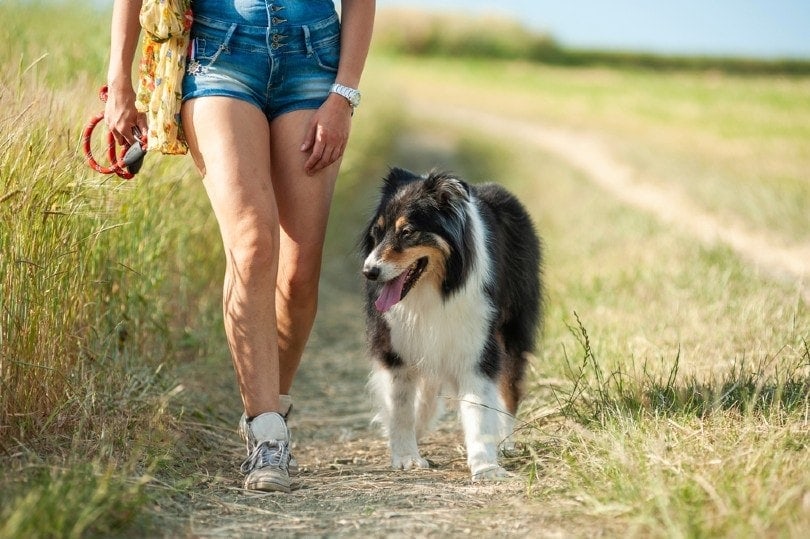
How Do I Care for a Dog With Burned Paws?
If your dog has burned their paws, take them to the vet so the extent of the injury can be assessed and your dog can receive some pain killers. If the burn is severe (there are blisters, the paw is bleeding, and/or the skin peels), there is a high risk of infection and a delay in the healing.
In the case of minor burns, when the skin is only red and irritated, here are the steps that you can take to help your dog after speaking to a vet:
- Remove the dog from the spilled chemical or surface that has led to the injury or burn.
- In case of a chemical exposure, make sure your dog doesn’t lick it off their paws, and give the paws a generous rinse with lukewarm water. Then dry and inspect them for injuries.
- Be mindful that your dog is in pain, and some dogs do not allow their paws to be checked or may attempt to bite due to the discomfort.
- Consult with a veterinarian to see if your dog needs veterinary care and to get instructions on what to do.
- In case of a thermal burn, you can try to keep the affected paw(s) in cold water for a few minutes, or use cold compresses at regular intervals, as advised by your vet. The cold water will help alleviate pain and discomfort, but overdoing it may cause skin sloughing if the damage is severe.
- Gently and carefully trim the fur between your dog’s paw pads if required and advised by the vet, so you can visualize the area better and monitor healing on a daily basis. Do not do it if your dog is very wriggly or you are not comfortable with trimming, as it may cause injuries to your dog’s skin.
- Disinfect the area with a mild vet-approved skin disinfectant according to your vet’s advice.
- Get an Elizabethan collar to prevent your dog from licking the sore area, which will make it worse.
- Avoid bandaging the paw without your vet’s input, as tight bandages can compromise blood supply and cause significant discomfort to your dog.
- Follow your vet’s instructions on wound care and management, ensure your dog receives all the required medication, and keep up with their vet appointments.
If the burn does not improve or seems to get worse, consult a veterinarian well ahead of your re-check appointment.
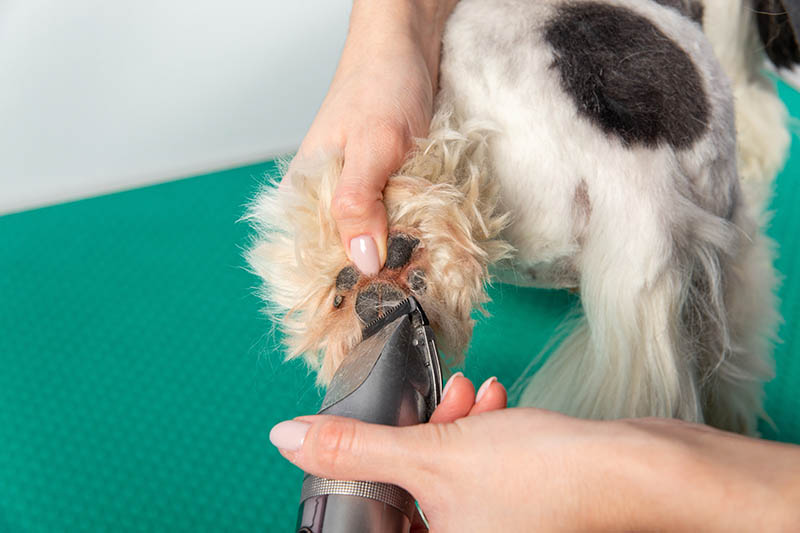
How to Prevent Paw Burns in Dogs
Take your dog for a walk when it is cooler outside and when the asphalt is not hot (in the morning or evening). You can also test the surface before taking your dog outside. If you can’t comfortably keep the palm of your hand on the surface for 10 seconds or more, it is too hot for your dog’s paws.
Sometimes, simply changing your dog’s walking routine is all you need to do to keep your pet’s paws safe. For example, you can choose to walk your dog on grass or soil.
Another alternative is shoes for dogs that are ideal for hot or cold surfaces. Allow your pet to adjust to these shoes before going out for a walk. Have your dog walk with them around the house without stumbling. However, still be mindful not to walk your dog in extremely hot or cold weather, as the shoes may not be sufficient to protect their paws, and they may still be at risk of heatstroke in the summer or frostbite in the winter. The heat is particularly dangerous for brachycephalic or flat-faced dogs that have compromised airways and struggle to cope with the heat.
You can also use paw wax to protect and moisturize your pet’s paws. This provides a protective barrier and keeps their paws hydrated. Moreover, these products can be applied every few days or weekly and are not harmful for pets in case they lick the product off their paws.
Frequently Asked Questions (FAQ)
How Long Do Dog Paw Burns Take to Heal?
In general, minor burns heal within a week. However, severe burns will take weeks to heal completely. Secondary infections must also be taken into consideration because they can prolong the healing time. For this reason, it is crucial to take your pet to the vet immediately to prevent complications if they have severely burned their paws.
Can I Walk My Dog if They Have a Sore Paw?
It is not recommended to walk your dog with a sore paw because it will only cause them more pain and discomfort and delay healing. Moreover, secondary infections can set in, which can lead to further complications. If your dog has injured their paw, give first aid and contact the veterinarian. If your vet has placed a paw bandage, keep it dry by using a plastic bag over it when taking your dog for a toilet break. Refrain from walking your dog until the wound is fully healed or the vet has given you a green light and has removed the bandage.

 Conclusion
Conclusion
You shouldn’t walk your dog on very hot surfaces or on ice because they can burn their paws. Stripped cables, boiling water, or corrosive substances can also cause paw burns to your four-legged friend. Most of the time, the clinical signs of burnt paws include lameness, a red and swollen area, and/or persistent licking of the affected paw. In severe cases, blisters, open wounds, bleeding, and secondary skin infections may also occur.
Take your dog to the vet as soon as possible if you think they have injured their paw(s) or are showing any of the above signs. Follow your vet’s instructions, apply any prescribed ointments or give other treatments, and protect the affected paw when taking your dog for a walk.
- You might be interested in: Why Are My Dogs Paws Pink and Black? 8 Vet-Approved Causes & How to Protect Them
Featured Image Credit: SingjaiStocker, Shutterstock



